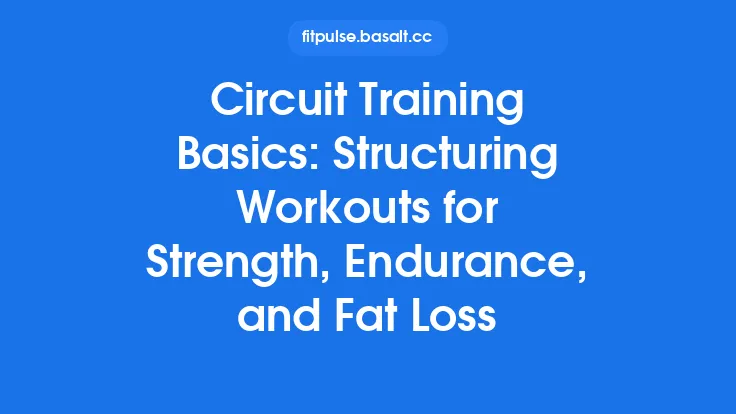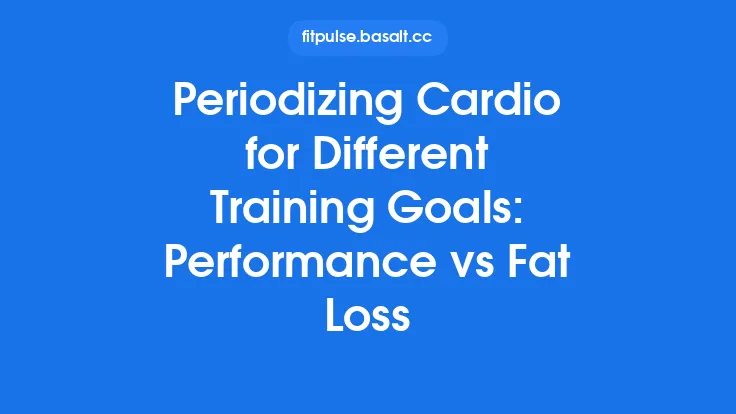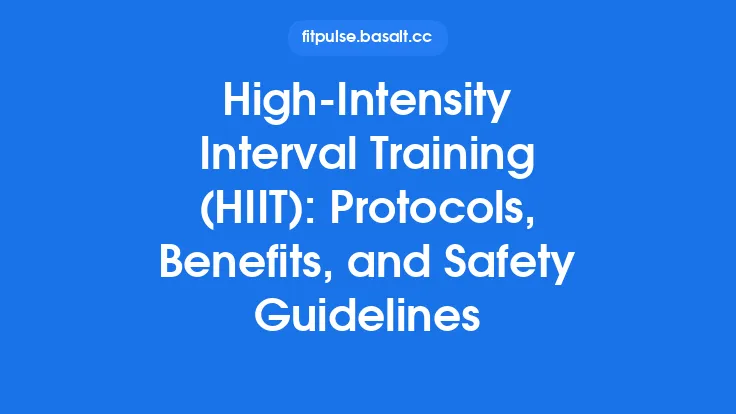High‑Intensity Interval Training (HIIT) has become a go‑to strategy for anyone who wants to shed excess body fat without spending hours on the treadmill or bike. The appeal lies in its promise of maximal metabolic impact in a minimal time window, a claim that is increasingly supported by peer‑reviewed research. This article delves into the evidence‑based mechanisms that make HIIT uniquely suited for time‑efficient fat loss, outlines practical ways to harness those mechanisms, and provides guidance on tracking results and staying safe while pursuing a leaner physique.
The Physiological Basis for Fat Loss with HIIT
1. Acute Energy Demand and Substrate Utilization
During a high‑intensity effort, the body’s immediate energy needs are met primarily through phosphocreatine (PCr) stores and anaerobic glycolysis. As the interval progresses, muscle glycogen becomes the dominant fuel, while circulating free fatty acids (FFAs) are mobilized but not yet oxidized at high rates. The critical shift occurs during the recovery periods, when the body repays the PCr pool, clears lactate, and restores homeostasis. This recovery phase is where a substantial proportion of fat oxidation takes place, especially when the work‑to‑rest ratio is sufficiently demanding to elicit a large oxygen debt.
2. Excess Post‑Exercise Oxygen Consumption (EPOC)
EPOC represents the elevated oxygen uptake that persists after the cessation of exercise. HIIT consistently produces a larger and more prolonged EPOC response than moderate‑intensity continuous training (MICT) of comparable duration. The magnitude of EPOC is proportional to the intensity and total work performed, leading to increased caloric expenditure for up to 24–48 hours post‑session. This “after‑burn” effect contributes meaningfully to total daily energy expenditure, especially when sessions are stacked throughout the week.
3. Hormonal Milieu Favorable to Lipolysis
High‑intensity bouts trigger acute spikes in catecholamines (epinephrine and norepinephrine), growth hormone (GH), and testosterone—all hormones that promote lipolysis and inhibit lipogenesis. The catecholamine surge enhances hormone‑sensitive lipase activity within adipocytes, liberating FFAs into the bloodstream. Simultaneously, the transient rise in GH supports adipose tissue mobilization and preserves lean mass during caloric deficits.
4. Improvements in Insulin Sensitivity and Metabolic Flexibility
Repeated HIIT exposures have been shown to upregulate GLUT4 transporters and improve skeletal muscle insulin signaling pathways. Enhanced insulin sensitivity reduces the propensity for post‑prandial glucose storage as fat and facilitates greater reliance on fatty acids during low‑intensity periods. Over time, this metabolic flexibility translates into a lower overall fat accretion rate, even when total caloric intake remains unchanged.
5. Mitochondrial Biogenesis and Oxidative Capacity
The repeated high‑energy demand of HIIT stimulates peroxisome proliferator‑activated receptor‑γ coactivator‑1α (PGC‑1α) expression, a master regulator of mitochondrial biogenesis. An expanded mitochondrial network improves the capacity for fatty‑acid oxidation, thereby increasing the proportion of calories derived from fat during both exercise and rest.
Key Research Findings on Time‑Efficient Fat Reduction
| Study | Population | Protocol Summary* | Primary Fat‑Loss Outcome |
|---|---|---|---|
| Keating et al., 2020 (Meta‑analysis) | 1,200 adults (mixed sex, BMI 25–35) | HIIT vs. MICT, matched for total work | HIIT produced ~0.5 kg greater visceral fat loss over 12 weeks |
| Boutcher, 2019 | 30 sedentary men | 3 × 4‑minute high‑intensity bouts, 2 × /week | 2.3 % reduction in total body fat, no loss of lean mass |
| Gillen et al., 2021 | 45 overweight women | 10 × 30‑second sprints, 3 × /week | Significant decrease in sub‑cutaneous abdominal fat (≈1.2 cm) |
| Stølen et al., 2022 | 60 older adults (≥65 y) | 2 × 6‑minute high‑intensity intervals, 2 × /week | Improved insulin sensitivity (HOMA‑IR ↓ 22 %) and modest fat loss (≈0.8 kg) |
\*While the exact interval structure is not the focus here, all protocols share a common feature: brief, maximal‑effort efforts followed by recovery periods that collectively occupy ≤30 minutes per session.
Take‑away: Across diverse age groups and fitness backgrounds, HIIT consistently yields superior reductions in visceral and sub‑cutaneous fat compared with traditional steady‑state cardio, even when total weekly training time is halved.
Optimizing Energy Expenditure: EPOC and Metabolic Flexibility
- Session Length vs. Frequency
Research indicates that the cumulative EPOC effect scales more with the intensity of each bout than with the total number of minutes spent exercising. A 20‑minute HIIT session can generate a comparable post‑exercise caloric burn to a 45‑minute MICT session, provided the intensity threshold (≈85 % HRmax) is met.
- Manipulating Recovery Duration
Shorter active recoveries (e.g., low‑intensity walking or light cycling) maintain an elevated heart rate, prolonging the oxygen debt and encouraging greater fat oxidation during the recovery window. Conversely, complete rest periods allow for rapid phosphocreatine replenishment, which may reduce the overall metabolic stress. Selecting a recovery strategy that aligns with the goal of maximizing EPOC is therefore crucial.
- Training in a Fasted State
Several acute studies have demonstrated that performing HIIT after an overnight fast amplifies circulating FFA concentrations during the session and augments post‑exercise fat oxidation. However, the chronic impact on body composition remains modest, and individual tolerance should guide implementation.
- Nutrient Timing Post‑HIIT
Consuming a modest protein‑rich meal (≈20 g) within the first two hours after a HIIT session supports muscle repair without blunting the lipolytic hormone response. Adding a low‑glycemic carbohydrate source can replenish glycogen for subsequent training days while still preserving the fat‑loss benefits.
Strategic Integration of HIIT with Nutrition for Fat Loss
| Nutritional Strategy | Rationale | Practical Tip |
|---|---|---|
| Moderate Caloric Deficit (10‑20 %) | Provides the energy imbalance needed for fat loss while preserving training quality | Use a food‑tracking app to maintain a consistent deficit; avoid drastic cuts that impair HIIT performance |
| Higher Protein Intake (1.6‑2.2 g·kg⁻¹ body weight) | Protects lean mass during the catabolic stress of HIIT | Distribute protein evenly across 3–4 meals; include leucine‑rich sources (e.g., whey, soy) post‑session |
| Low‑Glycemic Carbohydrates on HIIT Days | Sustains blood glucose without provoking insulin spikes that could blunt lipolysis | Opt for oats, quinoa, or sweet potatoes; pair with fiber and protein |
| Omega‑3 Fatty Acids | May enhance mitochondrial function and improve insulin sensitivity | Aim for 1–2 g EPA/DHA per day via fatty fish or high‑quality supplements |
| Hydration and Electrolytes | Supports cardiovascular performance and reduces perceived exertion | Consume 500 ml water 30 min before HIIT; add a pinch of sea salt if sweating heavily |
By aligning macronutrient distribution with the metabolic demands of HIIT, practitioners can amplify fat oxidation while safeguarding muscle tissue.
Monitoring and Adjusting Intensity Without Complex Ratios
While detailed interval prescriptions belong to a different discussion, maintaining the requisite intensity for fat‑loss benefits can be achieved through simple, reproducible methods:
- Rate of Perceived Exertion (RPE): Aim for an RPE of 8–9 on a 10‑point scale during the work phases. This subjective gauge correlates well with ≥85 % HRmax in most individuals.
- Heart‑Rate Zones: Use a heart‑rate monitor to stay within 85–95 % of maximal heart rate. Max HR can be estimated with the Tanaka formula (208 – 0.7 × age) for most adults.
- Power Output (if available): For cyclists or rowers, target a power output that exceeds 90 % of recent 5‑minute peak power.
- Breathlessness Index: A “talk test” where speaking more than a few words becomes difficult indicates sufficient intensity.
Periodically reassess these metrics (every 4–6 weeks) to ensure progressive stimulus. If RPE drops below 7 despite the same external load, it signals adaptation and the need for a modest increase in effort or load.
Practical Implementation for Busy Schedules
- Micro‑Sessions: Split a 20‑minute HIIT block into two 10‑minute bouts separated by a few hours of work or study. The cumulative metabolic stress remains comparable, and the approach fits into fragmented calendars.
- Embedded HIIT: Incorporate short, high‑intensity bursts into daily activities—e.g., sprint up a flight of stairs, perform a set of burpees during a coffee break, or use a stationary bike for a quick 5‑minute sprint before a meeting.
- Weekend “Power Days”: Allocate a longer session (≈30 minutes) on a non‑working day to achieve a higher total work volume without compromising weekday time constraints.
- Technology Aids: Leverage wearable devices that provide real‑time RPE or heart‑rate alerts, allowing you to stay within the target intensity without constantly checking a watch.
The key is consistency: even three 15‑minute HIIT sessions per week can generate meaningful fat‑loss outcomes when paired with an appropriate diet.
Assessing Progress and Interpreting Results
- Body‑Composition Tools: Dual‑energy X‑ray absorptiometry (DXA) remains the gold standard for tracking visceral and sub‑cutaneous fat changes. If unavailable, bioelectrical impedance analysis (BIA) with consistent hydration status can serve as a practical alternative.
- Circumference Measurements: Track waist, hip, and thigh girths monthly. A reduction of 2–3 cm in waist circumference often precedes noticeable weight loss.
- Performance Markers: Improvements in the number of high‑intensity repetitions completed, reduced RPE for the same work, or faster recovery heart‑rate (e.g., HR returning to <120 bpm within 2 minutes) indicate enhanced aerobic and anaerobic capacity, which correlates with increased fat oxidation.
- Metabolic Health Indicators: Periodic fasting glucose, insulin, and lipid panels can reveal favorable shifts even before visual changes appear.
When interpreting data, remember that HIIT may preserve lean mass while reducing fat, leading to modest changes on the scale but significant improvements in body composition.
Safety Considerations and Contraindications
- Medical Clearance: Individuals with uncontrolled hypertension, recent cardiac events, or severe musculoskeletal disorders should obtain physician approval before initiating HIIT.
- Joint Load Management: High‑impact modalities (e.g., sprinting, plyometrics) can exacerbate joint stress. Opt for low‑impact equipment (e.g., rowing, elliptical) if joint health is a concern.
- Progressive Acclimatization: Beginners should start with a reduced number of high‑intensity repetitions (e.g., 4–6) and gradually increase as tolerance improves. This mitigates the risk of acute injury and excessive cardiovascular strain.
- Monitoring Symptoms: Persistent dizziness, chest discomfort, or excessive shortness of breath warrant immediate cessation and medical evaluation.
- Recovery Emphasis: While the focus here is on time efficiency, adequate sleep (7–9 hours) and stress management are essential to prevent maladaptive hormonal responses that could blunt fat loss.
In summary, the convergence of acute metabolic disruption, hormonal amplification, and chronic adaptations makes HIIT a uniquely potent tool for time‑efficient fat loss. By grounding training decisions in robust scientific evidence—leveraging EPOC, optimizing nutrient timing, and employing simple intensity monitoring—practitioners can achieve meaningful reductions in body fat while preserving lean tissue, all within the constraints of a busy lifestyle. Consistent tracking, mindful nutrition, and adherence to safety guidelines will ensure that the benefits of HIIT are realized sustainably and healthily.





